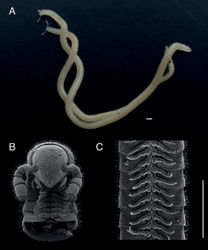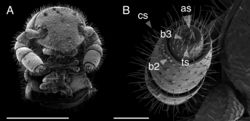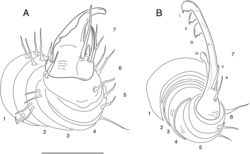Difference between revisions of "Illacme"
m (Imported from ZooKeys) |
m (1 revision imported) |
||
| (One intermediate revision by the same user not shown) | |||
| Line 3: | Line 3: | ||
{{Publication to wiki notice | {{Publication to wiki notice | ||
| − | | author = Marek, Paul E. AND | + | | author = Marek, Paul E. AND Hall, Charity L. AND Lee, Cedric AND Bailey, James AND Berger, Matt C. AND Kasson, Matt T. AND Shear, William |
| − | | author_abbreviated = Marek P AND | + | | author_abbreviated = Marek P AND Hall C AND Lee C AND Bailey J AND Berger M AND Kasson M AND Shear W |
| − | | year = | + | | year = 2023 |
| − | | title = | + | | title = A new species of ''Illacme'' from southern California (Siphonophorida, Siphonorhinidae) |
| journal = ZooKeys | | journal = ZooKeys | ||
| − | | volume = | + | | volume = 1167 |
| − | | pages = | + | | pages = 265--291 |
| − | | doi = 10.3897/zookeys. | + | | doi = 10.3897/zookeys.1167.102537 |
| − | | citationurl = | + | | citationurl = https://zookeys.pensoft.net/articles.php?id=102537&element_type=9 |
| − | | url = | + | | url = https://zookeys.pensoft.net/articles.php?id=102537 |
| publisher = Pensoft Publishers | | publisher = Pensoft Publishers | ||
| publisherurl = http://www.pensoft.net/ | | publisherurl = http://www.pensoft.net/ | ||
| − | }} | + | }} |
{{Treatment start | {{Treatment start | ||
| Line 26: | Line 26: | ||
| Taxon authority = Cook & Loomis, 1928 | | Taxon authority = Cook & Loomis, 1928 | ||
| Taxon status = | | Taxon status = | ||
| − | |||
| Wikispecies page name = Illacme | | Wikispecies page name = Illacme | ||
| Pensoft Profile = Illacme | | Pensoft Profile = Illacme | ||
| Line 32: | Line 31: | ||
==Type species== | ==Type species== | ||
| − | ''{{Taxon name|Illacme plenipes}}'' Cook | + | ''{{Taxon name|Illacme plenipes}}'' Cook & Loomis, 1928. |
| + | |||
| + | ==Species included== | ||
| + | ''{{Taxon name|Illacme plenipes}}'' Cook & Loomis, 1928; ''{{Taxon name|Illacme tobini}}'' Marek, Krejca & Shear, 2016; ''{{Taxon name|Illacme socal}}'' sp. nov. | ||
==Family placement== | ==Family placement== | ||
| − | ''{{Taxon name|Illacme}}'' is placed | + | The genus ''{{Taxon name|Illacme}}'' is placed in the family {{Taxon name|Siphonorhinidae}} based on the following morphological characters: Head pear-shaped (♂) or triangular (♀), not elongate nor with a beak, as in the {{Taxon name|Siphonophoridae}} (♂ Suppl. materials 1, 9: figs S1, S2, S32, S34; ♀ Fig. 1; Suppl. material 11: figs S36, S39). Antennae elbowed between antennomeres 3, 4 (Figs 1, 2; Suppl. materials 1, 10, 11: figs S2–S4, S36, S41). Antennomere 1 set deep in cranium, not fully visible dorsally as in {{Taxon name|Siphonophoridae}} (Suppl. material 1: figs S2, S4). Antennomere 2 longer than wide, conical, not doughnut-shaped nor wider than long as typical in {{Taxon name|Siphonophoridae}} (Suppl. material 1: figs S1, S4). Anterior margin of collum straight, not medially emarginate as in {{Taxon name|Siphonophoridae}}. Sterna with prominent midline triangular ridge, projecting ventrally (Suppl. material 5: fig. S19). Posterior gonopods with distal podomere divided into 2–5 branches with one branch spike-like ('''i–v''', Fig. 3B; Suppl. material 7: figs S25–S27). See also diagnoses of ''{{Taxon name|Illacme}}'' in Shelley (1996b<ref name="B29">{{aut|Shelley R}} (1996b) The milliped order {{Taxon name|Siphonophorida}} in the United States and northern Mexico.Myriapodologica4: 21–33. [http://www.vmnh.net/content/uploads/PDF/Research_and_Collections/Myriapodologica/Myriapodologica_v4_n4.pdf http://www.vmnh.net/content/uploads/PDF/Research_and_Collections/Myriapodologica/Myriapodologica_v4_n4.pdf]</ref >: 23), Marek et al. (2012<ref name="B16">{{aut|Marek P}}, {{aut|Shear W}}, {{aut|Bond J}} (2012) A redescription of the leggiest animal, the millipede ''{{Taxon name|Illacme plenipes}}'', with notes on its natural history and biogeography ({{Taxon name|Diplopoda}}, {{Taxon name|Siphonophorida}}, {{Taxon name|Siphonorhinidae}}).ZooKeys241: 77–112. https://doi.org/10.3897/zookeys.241.3831</ref >: 85; 2016<ref name="B17">{{aut|Marek P}}, {{aut|Krejca J}}, {{aut|Shear W}} (2016) A new species of ''{{Taxon name|Illacme}}'' Cook & Loomis, 1928 from Sequoia National Park, California, with a world catalog of the {{Taxon name|Siphonorhinidae}} ({{Taxon name|Diplopoda}}, {{Taxon name|Siphonophorida}}).ZooKeys626: 1–43. https://doi.org/10.3897/zookeys.626.9681</ref >: 7), and Enghoff et al. (2015<ref name="B5">{{aut|Enghoff H}}, {{aut|Golovatch S}}, {{aut|Short M}}, {{aut|Stoev P}}, {{aut|Wesener T}} (2015) {{Taxon name|Diplopoda}}–taxonomic overview. In: Minelli A (Ed.) Treatise on Zoology – Anatomy, Taxonomy, Biology.The {{Taxon name|Myriapoda}} 2. Brill, Leiden, 363–454. https://doi.org/10.1163/9789004188273_017</ref >: 386); and of {{Taxon name|Siphonorhinidae}} in Shelley and Hoffman (2004<ref name="B30">{{aut|Shelley R}}, {{aut|Hoffman R}} (2004) A contribution on the South African millipede genus, ''{{Taxon name|Nematozonium}}'' Verhoeff, 1939 ({{Taxon name|Siphonophorida}}: {{Taxon name|Siphonorhinidae}}).African Entomology12(2): 217–222.</ref >: 218), Wesener (2014<ref name="B36">{{aut|Wesener T}} (2014) First records of the order {{Taxon name|Siphonophorida}} from Madagascar and Mauritius ({{Taxon name|Diplopoda}}).Revue suisse de Zoologie121: 415–423. [https://www.biodiversitylibrary.org/page/52965457 https://www.biodiversitylibrary.org/page/52965457]</ref >: 417), and Enghoff et al. (2015<ref name="B5">{{aut|Enghoff H}}, {{aut|Golovatch S}}, {{aut|Short M}}, {{aut|Stoev P}}, {{aut|Wesener T}} (2015) {{Taxon name|Diplopoda}}–taxonomic overview. In: Minelli A (Ed.) Treatise on Zoology – Anatomy, Taxonomy, Biology.The {{Taxon name|Myriapoda}} 2. Brill, Leiden, 363–454. https://doi.org/10.1163/9789004188273_017</ref >: 386). |
| − | + | ||
| − | = | + | |
| − | + | ||
==Taxon Treatment== | ==Taxon Treatment== | ||
| − | *{{aut|Marek, P}}; {{aut| | + | *{{aut|Marek, P}}; {{aut|Hall, C}}; {{aut|Lee, C}}; {{aut|Bailey, J}}; {{aut|Berger, M}}; {{aut|Kasson, M}}; {{aut|Shear, W}}; 2023: A new species of ''Illacme'' from southern California (Siphonophorida, Siphonorhinidae) [https://zookeys.pensoft.net/ ''ZooKeys'',] '''1167''': 265-291. {{doi|10.3897/zookeys.1167.102537}} |
| − | + | ||
| − | + | ||
| − | + | ||
| − | + | ||
==Images== | ==Images== | ||
{{Gallery | lines=5 | width=250 | {{Gallery | lines=5 | width=250 | ||
| − | |1= File: | + | |1= File:zookeys-1167-265_article-102537__-g001.jpg|2= '''Figure 1.''' ''{{Taxon name|Illacme socal}}'' sp. nov. '''A''' ♂ holotype, MPE04621, and ♀ paratype, MPE04622 (with head at top) '''B''' scanning electron micrograph of the head of ♀, MPE04625 '''C''' micrograph of midbody rings of ♀, ventral view, MPE04625. Scale bars: 1 mm ('''A'''); 0.5 mm ('''B, C'''). |
| − | |3= File: | + | |3= File:zookeys-1167-265_article-102537__-g002.jpg|4= '''Figure 2.''' ''{{Taxon name|Illacme socal}}'' sp. nov. Scanning electron micrographs '''A''' left, head and anterior rings of ♂ holotype, ventral view (MPE04621) '''B''' right antenna of ♀ paratype, apical view (MPE04976). Scale bars: 400 µm ('''A'''); 50 µm ('''B'''). Abbreviations: '''as''', apical cones; '''b2''', small basiconic sensillum; '''b3''', spiniform basiconic sensillum; '''cs''', chaetiform sensillum; '''ts''', trichoid sensillum. |
| − | + | |5= File:zookeys-1167-265_article-102537__-g003.jpg|6= '''Figure 3.''' ''{{Taxon name|Illacme socal}}'' sp. nov. ♂ '''A''' anterior gonopod, left side, medial view '''B''' posterior gonopod, left side, medial view. Podomeres numbered. Scale bar: 50 µm ('''A, B'''). Abbreviations: '''i''' – '''v''', styliform articles of the posterior gonopodal apex (podomere 7); '''s''', accessory seta. | |
| − | + | ||
| − | | | + | |
| − | + | ||
}} | }} | ||
| + | |||
| + | ==Other References== | ||
| + | |||
| + | <references /> | ||
Latest revision as of 14:11, 21 June 2023
| Notice: | This page is derived from the original publication listed below, whose author(s) should always be credited. Further contributors may edit and improve the content of this page and, consequently, need to be credited as well (see page history). Any assessment of factual correctness requires a careful review of the original article as well as of subsequent contributions.
If you are uncertain whether your planned contribution is correct or not, we suggest that you use the associated discussion page instead of editing the page directly. This page should be cited as follows (rationale):
Citation formats to copy and paste
BibTeX: @article{Marek2023ZooKeys1167, RIS/ Endnote: TY - JOUR Wikipedia/ Citizendium: <ref name="Marek2023ZooKeys1167">{{Citation See also the citation download page at the journal. |
Ordo: Siphonophorida
Familia: Siphonorhinidae
Name
Illacme Cook & Loomis, 1928 – Wikispecies link – Pensoft Profile
Type species
Illacme plenipes Cook & Loomis, 1928.
Species included
Illacme plenipes Cook & Loomis, 1928; Illacme tobini Marek, Krejca & Shear, 2016; Illacme socal sp. nov.
Family placement
The genus Illacme is placed in the family Siphonorhinidae based on the following morphological characters: Head pear-shaped (♂) or triangular (♀), not elongate nor with a beak, as in the Siphonophoridae (♂ Suppl. materials 1, 9: figs S1, S2, S32, S34; ♀ Fig. 1; Suppl. material 11: figs S36, S39). Antennae elbowed between antennomeres 3, 4 (Figs 1, 2; Suppl. materials 1, 10, 11: figs S2–S4, S36, S41). Antennomere 1 set deep in cranium, not fully visible dorsally as in Siphonophoridae (Suppl. material 1: figs S2, S4). Antennomere 2 longer than wide, conical, not doughnut-shaped nor wider than long as typical in Siphonophoridae (Suppl. material 1: figs S1, S4). Anterior margin of collum straight, not medially emarginate as in Siphonophoridae. Sterna with prominent midline triangular ridge, projecting ventrally (Suppl. material 5: fig. S19). Posterior gonopods with distal podomere divided into 2–5 branches with one branch spike-like (i–v, Fig. 3B; Suppl. material 7: figs S25–S27). See also diagnoses of Illacme in Shelley (1996b[1]: 23), Marek et al. (2012[2]: 85; 2016[3]: 7), and Enghoff et al. (2015[4]: 386); and of Siphonorhinidae in Shelley and Hoffman (2004[5]: 218), Wesener (2014[6]: 417), and Enghoff et al. (2015[4]: 386).
Taxon Treatment
- Marek, P; Hall, C; Lee, C; Bailey, J; Berger, M; Kasson, M; Shear, W; 2023: A new species of Illacme from southern California (Siphonophorida, Siphonorhinidae) ZooKeys, 1167: 265-291. doi
Images
|
Other References
- ↑ Shelley R (1996b) The milliped order Siphonophorida in the United States and northern Mexico.Myriapodologica4: 21–33. http://www.vmnh.net/content/uploads/PDF/Research_and_Collections/Myriapodologica/Myriapodologica_v4_n4.pdf
- ↑ Marek P, Shear W, Bond J (2012) A redescription of the leggiest animal, the millipede Illacme plenipes, with notes on its natural history and biogeography (Diplopoda, Siphonophorida, Siphonorhinidae).ZooKeys241: 77–112. https://doi.org/10.3897/zookeys.241.3831
- ↑ Marek P, Krejca J, Shear W (2016) A new species of Illacme Cook & Loomis, 1928 from Sequoia National Park, California, with a world catalog of the Siphonorhinidae (Diplopoda, Siphonophorida).ZooKeys626: 1–43. https://doi.org/10.3897/zookeys.626.9681
- ↑ 4.0 4.1 Enghoff H, Golovatch S, Short M, Stoev P, Wesener T (2015) Diplopoda–taxonomic overview. In: Minelli A (Ed.) Treatise on Zoology – Anatomy, Taxonomy, Biology.The Myriapoda 2. Brill, Leiden, 363–454. https://doi.org/10.1163/9789004188273_017
- ↑ Shelley R, Hoffman R (2004) A contribution on the South African millipede genus, Nematozonium Verhoeff, 1939 (Siphonophorida: Siphonorhinidae).African Entomology12(2): 217–222.
- ↑ Wesener T (2014) First records of the order Siphonophorida from Madagascar and Mauritius (Diplopoda).Revue suisse de Zoologie121: 415–423. https://www.biodiversitylibrary.org/page/52965457


